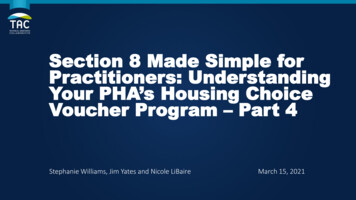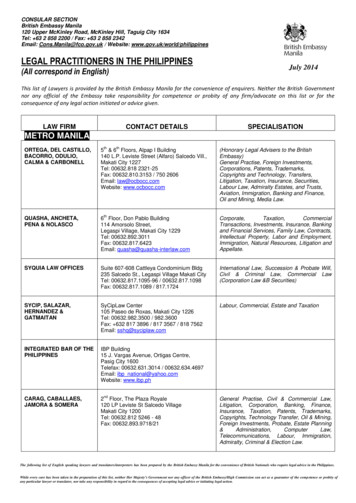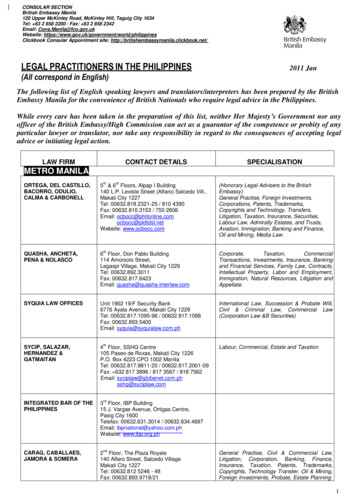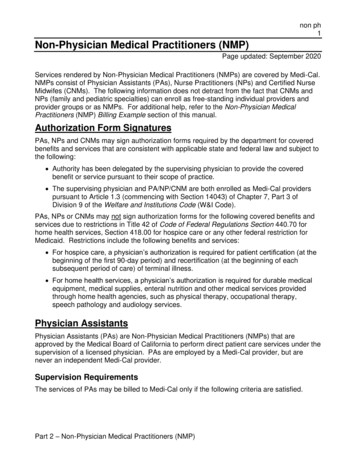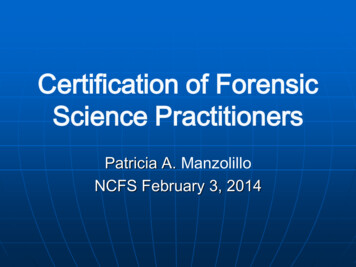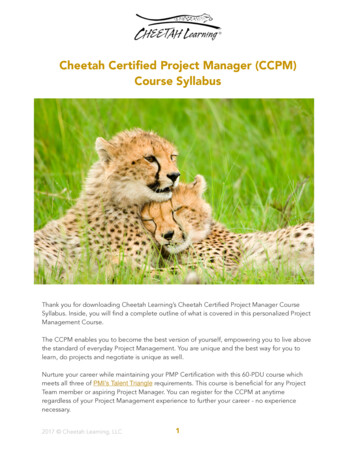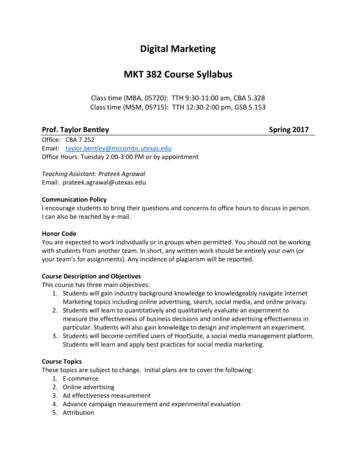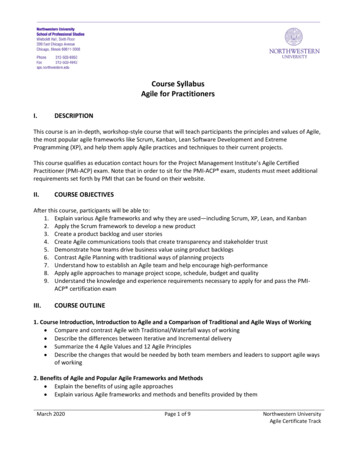
Transcription
Course SyllabusAgile for PractitionersI.DESCRIPTIONThis course is an in-depth, workshop-style course that will teach participants the principles and values of Agile,the most popular agile frameworks like Scrum, Kanban, Lean Software Development and ExtremeProgramming (XP), and help them apply Agile practices and techniques to their current projects.This course qualifies as education contact hours for the Project Management Institute’s Agile CertifiedPractitioner (PMI-ACP) exam. Note that in order to sit for the PMI-ACP exam, students must meet additionalrequirements set forth by PMI that can be found on their website.II.COURSE OBJECTIVESAfter this course, participants will be able to:1. Explain various Agile frameworks and why they are used—including Scrum, XP, Lean, and Kanban2. Apply the Scrum framework to develop a new product3. Create a product backlog and user stories4. Create Agile communications tools that create transparency and stakeholder trust5. Demonstrate how teams drive business value using product backlogs6. Contrast Agile Planning with traditional ways of planning projects7. Understand how to establish an Agile team and help encourage high-performance8. Apply agile approaches to manage project scope, schedule, budget and quality9. Understand the knowledge and experience requirements necessary to apply for and pass the PMIACP certification examIII.COURSE OUTLINE1. Course Introduction, Introduction to Agile and a Comparison of Traditional and Agile Ways of Working Compare and contrast Agile with Traditional/Waterfall ways of working Describe the differences between Iterative and Incremental delivery Summarize the 4 Agile Values and 12 Agile Principles Describe the changes that would be needed by both team members and leaders to support agile waysof working2. Benefits of Agile and Popular Agile Frameworks and Methods Explain the benefits of using agile approaches Explain various Agile frameworks and methods and benefits provided by themMarch 2020Page 1 of 9Northwestern UniversityAgile Certificate Track
Demonstrate how teams drive business value using Agile approachesSupport an argument for delivering a minimum viable product3. Planning Agile Projects Develop charter artifacts for a new projects using agile techniques Create an initial product backlog for a new project Contrast Agile Planning with traditional ways of planning projects Use release planning techniques to plan an agile project4. Exploring Scrum and High-Performing Teams Understand how to establish a Scrum team and help encourage high-performance. Apply techniques to continuously improve team performance and productivity Apply agile approaches to manage project scope, schedule, budget and quality Analyze team performance reports to determine corrective actions5. Working Together as an Agile Team Apply the Scrum framework to develop a new product Evaluate whether an organization has implemented the Scrum roles per the Scrum Guide Create Agile communications tools that create transparency and stakeholder trust Evaluate the level of conflict and recommend strategies to resolve the conflict6. Miscellaneous Agile Topics and the PMI-ACP Exam IV.Compare various communications methods and identify those that will be most effective for an agileteam.Recognize challenges and approaches to use with distributed teams.Engage team members in resolving problemsApply value stream mapping to analyze a processRevise a project forecast based on actual team progressUnderstand the knowledge and experience requirements necessary to apply for and pass the PMIACP certification examGRADING POLICYParticipation is the key to learning in this class. To facilitate your learning, there will be numerous team andclass discussion topics, and the exercises. You will be graded on your participation in the team and classdiscussions, Q&A throughout the day, and exercises. It is important that you show up to every class in order toget the most out of your learning experience.March 2020Page 2 of 9Northwestern UniversityAgile Certificate Track
Grading for this class is based on in-class participation and engagement with your group. To pass the course,you need to come to every day of class and participate. If you need a letter grade for reimbursement, speakto the instructor at the start of the first class.V.Course Map – Agile Certificate ProgramCOURSE TOPICSAgile forPractitioners(PROJ PMI403-0)Leading andCoaching AgileTeams(PROJ PMI350-0)AgileEstimatingand Planning(PROJ PMI360-0)Supporting anAgile Transformation(PROJ PMI365-0)Agile Introduction, Values & PrinciplesLean PrinciplesOverview of Scrum, Lean, Kanban, & XPBenefits of AgileKanbanValue Driven DevelopmentPlanning Agile ProjectsScrum Framework & SimulationPMI-ACP CertificationLeading Beyond the Agile TeamLeading Agile TeamsAgile vs Traditional ApproachesMisconceptions about AgileScaling AgileAgile Estimating TechniquesBuilding Your Agile ScheduleCoaching Agile TeamsAdvanced Agile ApproachesAgile Metrics and ReportingAddress Organizational ImpedimentsAn Agile Leaders ToolkitAgile Adoption PatternsIteration (Sprint) PlanningA Change Agent’s ToolkitAssessing Your Organizational Culture for AgileMarch 2020Page 3 of 9Northwestern UniversityAgile Certificate Track
COURSE TOPICSAgile forPractitioners(PROJ PMI403-0)Leading andCoaching AgileTeams(PROJ PMI350-0)AgileEstimatingand Planning(PROJ PMI360-0)Supporting anAgile Transformation(PROJ PMI365-0)Creating your Agile Transformation RoadmapVI.BIBLIOGRAPHY12 Source Books for the PMI-ACP: Adkins, Lyssa. Coaching Agile Teams: A Companion for ScrumMasters, Agile Coaches, and Project Managers inTransition. Addison-Wesley. 2010.Cockburn, Alistair. Agile Software Development: The Cooperative Game, Second EditionCohn, Mike. Agile Estimating and Planning. Pearson Education. 2006Cohn, Mike. User Stories Applied: For Agile Software Development.Derby, Esther. Agile Retrospectives: Making Good Teams Great. Pragmatic Bookshelf. 2006.Highsmith, Jim. Agile Project Management: Creating Innovative Products. Addison-Wesley. 2010.Sliger, Michele and Broderick, Stacia. The Software Project Managers Bridge to Agility. Addison-Wesley. 2008.Shalloway, Alan, et al. Lean-Agile Software Development: Achieving Enterprise Agility. Addison-WesleyProfessional. 2009Wysocki, Robert K. Effective Project Management: Traditional, Agile, Extreme. Wiley. 2013Rawsthorne Dan with Doug Shimp Exploring Scrum: The Fundamentals. CreateSpace Independent PublishingPlatform. 2013.Hammarberg, Marcus and Joakim Sunden. Kanban In Action. Manning Publications. 2014Anderson, David J. Kanban: Successful Evolutionary Change for your Technology Business. Blue Hole Press. 2014Other Helpful Books and Articles: Beck, Kent. Extreme Programming Explained. Addison-Wesley. 2004.Mersino, Anthony. Emotional Intelligence for Project Managers: The People Skills You Need to Succeed.AMACOM. 2013.Mersino, Anthony. Agile Project Management: A Nuts and Bolts Guide to Success. Vitality Chicago. 2015.Poppendieck, Mary and Poppendieck, Tom. Lean Software Development: An Agile Toolkit. Addison-Wesley.2003.Project Management Institute. The PMI-ACP Examination Content Outline. December 2014. Retrieve from:http://www.pmi.org/en/Certification/ /media/Files/PDF/Agile/PMI Agile Certification Content Outline.ashxProject Management Institute. The PMI-ACP Handbook Certification.aspx)Sutherland, Jeff and Schwaber, Ken. The Scrum Guide. 2017. (http://www.scrum.org/Scrum-Guides)March 2020Page 4 of 9Northwestern UniversityAgile Certificate Track
VersionOne. The 10th Annual Survey of Agile Development. May 7, 2013. Retrieve nual-State-of-Agile-Report.pdfRoyce, Winston. Managing the Development of Large Software Systems. IEEE WESCON Proceedings. 1970Womack, James and Jones, Daniel. The Machine That Changed the World. Free Press. 2007.Salovey, Peter and Mayer, John. Emotional Intelligence. Psychology Today. 1990.Pink, Daniel. Drive: The Surprising Truth About What Motivates Us. Riverhead Books. 20009Tabaka, Jean. Collaboration Explained. Addison-Wesley. 2006.Herzberg, Frederick. One More Time: How Do You Motivate Employees. Harvard Business School Press. 2008.Schein, Edgar. Humble Inquiry: The Gentle Art of Asking Instead of Telling. Berrett-Koehler Publishers. 2013.Larman, Craig & Vodde, Bas. Scaling Lean & Agile Development: Thinking and Organizational Tools for Large-ScaleScrum. Addison-Wesley Professional. 2008Web Posts Used in Class: Santeo: A History of Agile,http://www.santeon.com/download/Santeon HistoryofAgileSoftwareDevelopment.pdfPMI: 7 Domains of the PMI-ACP, ersionOne: 11th Annual State of Agile Report, 2017, http://stateofagile.versionone.comGene Kim: The Top 10 Things You Need to Know about DevOps,https://www.thinkhdi.com/ ps-kim.pdfAgile42: 6 Core Kanban Practices, ame/Digite: What is Kanban, https://www.digite.com/kanban/what-is-kanban/The Agile Executive: Standish Group Chaos Reports standish-group-chaos-reports-revisited/VersionOne: Agile Value Proposition, e-developmentbenefits/Science Daily: Working Together In "War Rooms" Doubles Teams' Productivity, University Of MichiganResearchers Find 06144705.htmPMI: Conflict Resolution, e-project-teams-navigate-conflict6760Slideshare: Qs Approach To Project Cost, -project-costScrum Primer: The Scrum Primer, .pdfScrum Inc: The Scrum Papers, https://www.scruminc.com/scrumpapers.pdfScrum Inc: Agile Contracts: Money for Nothing and Your Change for Free, nothing-and/Videos Used in Class: VersionOne: The Agile Manifesto - 4 Agile Values Explained, https://www.youtube.com/watch?v rf8Gi2RLKWQAxosoft: Intro to Kanban in Under 3 minutes, https://youtu.be/R8dYLbJiTUEHenrik Kniberg: Kanban and Scrum – Making the most of Both, https://vimeo.com/16918747March 2020Page 5 of 9Northwestern UniversityAgile Certificate Track
McDermott Chris: The Other Side of Kanban, https://youtu.be/klpmzhBiMokConstrux: How to Build a Kanban Board, https://youtu.be/N3BoLRVXoI0HatsiekiedeeDotTV: A Funny Scrum Master Movie with Jeff Sutherland, https://youtu.be/oheekef7oJkAdam Weisbart: Stuff Bad Scrum Masters Say, https://youtu.be/GGbsgs611MMMarch 2020Page 6 of 9Northwestern UniversityAgile Certificate Track
VII.GLOSSARY OF AGILE TERMSTermDefiniEonBurndown ChartA burndown chart is a visual tool for measuring and displaying team progress. The most commonburndown chart represents remaining work in hours or tasks in a sprint. Burndown or Burnup chartsmay also be used to measure the progress of compleNon of user stories at an iteraNon or releaselevel.Product OwnerThe Product Owner is a member of the Scrum team that represents the voice of the customer and isaccountable for ensuring that the team delivers value to the business. The Capability or ProductOwner writes customer-centric items (typically user stories), prioriNzes them, and adds them to theProduct Backlog.Daily Scrum / DailyMeeEng / DailyStandupA Daily Standup or Scrum is a meeNng of the scrum team (5-9 members, cross funcNonal) thathappens at the same Nme every day and should last 15 minutes or less. The meeNng is designed to allthe team to coordinate their efforts, and plan their days based on the flow and challenges of thedevelopment process. Each team member should answer 3 quesNons: what did I do yesterday, whatam I planning to do today, and what impediments do I currently have?DefiniEon of Done(DoD)The DefiniNon of Done is the team’s agreement on what consNtutes done for a user story or backlogitem. This agreement determines the tasks that the team needs to do to consider something done.This is to encourage being as close to producNon ready as possible within a sprint.DefiniEon of Ready(DoR)The DefiniNon of Ready is the team’s agreement on the characterisNcs of a user story that wouldmake it ready to bring into a sprint to be worked on. User stories are made ready during backlogrefinement sessions which take place in advance of the sprint the items will be completed in.Empirical ProcessControlEmpirical process control is used with processes that are highly variable and unpredictable. It isbased on inspecNng the results of the process and making regular adjustments. It is oRen contrastedwith predicNve approaches which assume results can be predicted.EpicA term for a very large user story that is eventually broken down into smaller stories.MVP (MinimumViable Product)A Minimum Viable Product represents a version of the product which has just those features thatallow the product to be deployed, and no more.Pair ProgrammingPair programming is an Agile soRware development technique in which two programmers worktogether at one workstaNon. One types in code while the other reviews each line of code as it istyped in. The person typing is called the driver. The person reviewing the code is called the observer(or navigator). The two programmers switch roles frequently. Benefits include beSer design, fewerbugs, and fewer key person dependencies.PairingPairing is a variaNon of pair programming where two people work together. This could include crossfuncNonal (tester and developer), or even within the same discipline (analyst analyst). Benefitsinclude knowledge transfer, defect reducNon, and team-building.Planning PokerPlanning poker is a consensus-based technique for esNmaNng based on relaNve size of user stories. Itis based on the wideband Delphi technique which uses crowd-sourcing to develop more consistentand accurate esNmates of work. This technique is similar to the planning game in ExtremeProgramming.PotenEally ShippableIncrementThe PotenNally Shippable Increment (PSI) or PotenNally Shippable Product Increment (PSPI) is a smallverNcal slice of funcNonality that results from each sprint or iteraNon of an Agile project.March 2020Page 7 of 9Northwestern UniversityAgile Certificate Track
TermDefiniEonProduct BacklogThe Product Backlog is a rank ordered list of the user stories that serve as the product or projectrequirements. The Product Owner is maintained by the Product Owner.Product Backlog ItemA product backlog item is an individual feature or funcNon for the soluNon. User stories are oneformat for a product backlog item.Product OwnerSee Capability Owner.RefactoringRefactoring is an XP technical pracNce. It is the process of improving soRware design, withoutchanging the funcNonality.ScrumScrum is a development framework developed by Ken Schwaber and Jeff Sutherland which is used toaddress complex adapNve problems, while producNvely and creaNvely delivering products of thehighest possible value. It is based on the adapNve and iteraNve methodology of soRwaredevelopment. The name was taken from the game of rugby.Scrum MasterThe Scrum Master is a role on the scrum team with accountability for removing impediments to theteam’s ability to deliver the sprint goal/deliverables. The Scrum Master is a servant leader. TheScrum Master ensures that the Scrum process is followed by the team, and they protect the team andkeep them focused on the tasks at hand.SpecificaEon byExample (SBE)SpecificaNon by example is a method of producing living requirements which can be translated intoautomated acceptance tests (ATDD).SpikeA spike is a specific type of user story that represents a short, Nme-boxed piece of research.SprintA Sprint (or iteraNon) is a fixed Nmebox that serves as a container for all the Scrum events. Duringthe Sprint, the Scrum team plans their work, produces working soRware, reviews their output, andthen holds a retrospecNve. The term Sprint comes from the Scrum framework and is analogous tothe term IteraNon. Most Scrum teams use sprints that are 2-4 weeks long.Sprint BacklogThe Sprint Backlog is an output of Sprint Planning, where the team forecasts the backlog items andtasks that they will complete during the sprint.Sprint PlanningSprint or iteraNon planning is a key scrum meeNng that occurs at the start of each iteraNon. ThemeeNng is in two parts; during the first part of this meeNng, the Product Owner describes the highestpriority features to the team as described on the Product Backlog. In the second part of the meeNng,the team then agrees on the number of features they can accomplish in the sprint and plans out thetasks required to achieve delivery of those features.Sprint RetrospecEveThe RetrospecNve is the Scrum event that happens at the end of every Sprint to review lessonslearned and to discuss how the team can be more efficient in the future. It is based on the scrumprinciples of inspect and adapt.Sprint ReviewThe Sprint Review is a Scrum MeeNng that is held at the end of each iteraNon, this serves as a briefreview of the soluNon developed in the previous Sprint. During the review, the soRware increment isreviewed and accepted or rejected. Newly idenNfied business needs from the Sprint Review areadded to the Product Backlog.Story PointsStory points are a relaNve measure used by Agile teams to represent the complexity and size of a userstory. Points are used to provide a relaNve measure between two user stories, and cannot becompared between two teams.March 2020Page 8 of 9Northwestern UniversityAgile Certificate Track
TermDefiniEonTaskA product backlog item can be broken down into one or more tasks. Tasks are esNmated in hoursduring iteraNon planning, and then re-esNmated daily once a team member begins working on them.TaskboardA taskboard is a visual representaNon of the Sprint Backlog. It is generally a wall chart with cardsand/or sNcky notes that represents all the work (user stories and tasks) for a given iteraNon. Thenotes are moved across the board to show progress.TeamThe Dev team is a cross-funcNonal and self-organizing group responsible for delivering the product. Ateam is typically made up of 5–9 people who do all the actual work needed to be done with aparNcular piece of funcNonality (analyze, design, develop, test, technical communicaNon, document,etc.).Technical DebtTechnical Debt is a consequence of poor or evolving soRware architecture and soRware developmentwithin a codebase. Technical debt can be thought of as work that needs to be done before aparNcular job can be considered complete. It is relevant because of the cost and risk of makingchanges to products with high technical debt.User StoryA user story is a very high-level definiNon of a business need, containing just enough informaNon sothat the team can produce a reasonable esNmate of the effort to implement it. A user story tells thewho, what and why, in business language. A user story is not detailed or a subsNtute forconversaNon; in fact, it is a placeholder to have a conversaNon between the users and the team.VelocityVelocity is a relaNve number which describes how much work the team can get done in story pointsover a period of Nme.WIPWork in Progress, WIP represents any work that has been started but has yet to be completed. Agileteams strive to minimize work in progress so that they maximize throughput.March 2020Page 9 of 9Northwestern UniversityAgile Certificate Track
(PROJ_PMI 403-0) Leading and Coaching Agile Teams (PROJ_PMI 350-0) Agile Estimating and Planning (PROJ_PMI 360-0) Supporting an Agile Trans-formation (PROJ_PMI 365-0) Creating your Agile Transformation Roadmap VI. BIBLIOGRAPHY 12 Source Books for the



